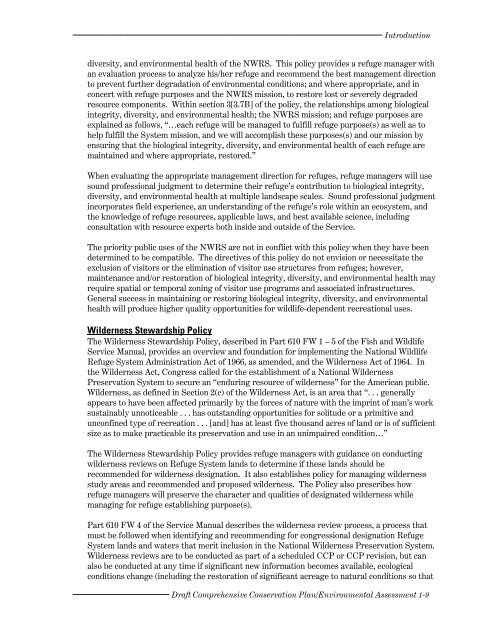Chapters 1 - U.S. Fish and Wildlife Service
Chapters 1 - U.S. Fish and Wildlife Service
Chapters 1 - U.S. Fish and Wildlife Service
You also want an ePaper? Increase the reach of your titles
YUMPU automatically turns print PDFs into web optimized ePapers that Google loves.
Introduction<br />
diversity, <strong>and</strong> environmental health of the NWRS. This policy provides a refuge manager with<br />
an evaluation process to analyze his/her refuge <strong>and</strong> recommend the best management direction<br />
to prevent further degradation of environmental conditions; <strong>and</strong> where appropriate, <strong>and</strong> in<br />
concert with refuge purposes <strong>and</strong> the NWRS mission, to restore lost or severely degraded<br />
resource components. Within section 3[3.7B] of the policy, the relationships among biological<br />
integrity, diversity, <strong>and</strong> environmental health; the NWRS mission; <strong>and</strong> refuge purposes are<br />
explained as follows, “…each refuge will be managed to fulfill refuge purpose(s) as well as to<br />
help fulfill the System mission, <strong>and</strong> we will accomplish these purposes(s) <strong>and</strong> our mission by<br />
ensuring that the biological integrity, diversity, <strong>and</strong> environmental health of each refuge are<br />
maintained <strong>and</strong> where appropriate, restored.”<br />
When evaluating the appropriate management direction for refuges, refuge managers will use<br />
sound professional judgment to determine their refuge’s contribution to biological integrity,<br />
diversity, <strong>and</strong> environmental health at multiple l<strong>and</strong>scape scales. Sound professional judgment<br />
incorporates field experience, an underst<strong>and</strong>ing of the refuge’s role within an ecosystem, <strong>and</strong><br />
the knowledge of refuge resources, applicable laws, <strong>and</strong> best available science, including<br />
consultation with resource experts both inside <strong>and</strong> outside of the <strong>Service</strong>.<br />
The priority public uses of the NWRS are not in conflict with this policy when they have been<br />
determined to be compatible. The directives of this policy do not envision or necessitate the<br />
exclusion of visitors or the elimination of visitor use structures from refuges; however,<br />
maintenance <strong>and</strong>/or restoration of biological integrity, diversity, <strong>and</strong> environmental health may<br />
require spatial or temporal zoning of visitor use programs <strong>and</strong> associated infrastructures.<br />
General success in maintaining or restoring biological integrity, diversity, <strong>and</strong> environmental<br />
health will produce higher quality opportunities for wildlife-dependent recreational uses.<br />
Wilderness Stewardship Policy<br />
The Wilderness Stewardship Policy, described in Part 610 FW 1 – 5 of the <strong>Fish</strong> <strong>and</strong> <strong>Wildlife</strong><br />
<strong>Service</strong> Manual, provides an overview <strong>and</strong> foundation for implementing the National <strong>Wildlife</strong><br />
Refuge System Administration Act of 1966, as amended, <strong>and</strong> the Wilderness Act of 1964. In<br />
the Wilderness Act, Congress called for the establishment of a National Wilderness<br />
Preservation System to secure an ‘‘enduring resource of wilderness’’ for the American public.<br />
Wilderness, as defined in Section 2(c) of the Wilderness Act, is an area that “. . . generally<br />
appears to have been affected primarily by the forces of nature with the imprint of man’s work<br />
sustainably unnoticeable . . . has outst<strong>and</strong>ing opportunities for solitude or a primitive <strong>and</strong><br />
unconfined type of recreation . . . [<strong>and</strong>] has at least five thous<strong>and</strong> acres of l<strong>and</strong> or is of sufficient<br />
size as to make practicable its preservation <strong>and</strong> use in an unimpaired condition…”<br />
The Wilderness Stewardship Policy provides refuge managers with guidance on conducting<br />
wilderness reviews on Refuge System l<strong>and</strong>s to determine if these l<strong>and</strong>s should be<br />
recommended for wilderness designation. It also establishes policy for managing wilderness<br />
study areas <strong>and</strong> recommended <strong>and</strong> proposed wilderness. The Policy also prescribes how<br />
refuge managers will preserve the character <strong>and</strong> qualities of designated wilderness while<br />
managing for refuge establishing purpose(s).<br />
Part 610 FW 4 of the <strong>Service</strong> Manual describes the wilderness review process, a process that<br />
must be followed when identifying <strong>and</strong> recommending for congressional designation Refuge<br />
System l<strong>and</strong>s <strong>and</strong> waters that merit inclusion in the National Wilderness Preservation System.<br />
Wilderness reviews are to be conducted as part of a scheduled CCP or CCP revision, but can<br />
also be conducted at any time if significant new information becomes available, ecological<br />
conditions change (including the restoration of significant acreage to natural conditions so that<br />
Draft Comprehensive Conservation Plan/Environmental Assessment 1-9

















